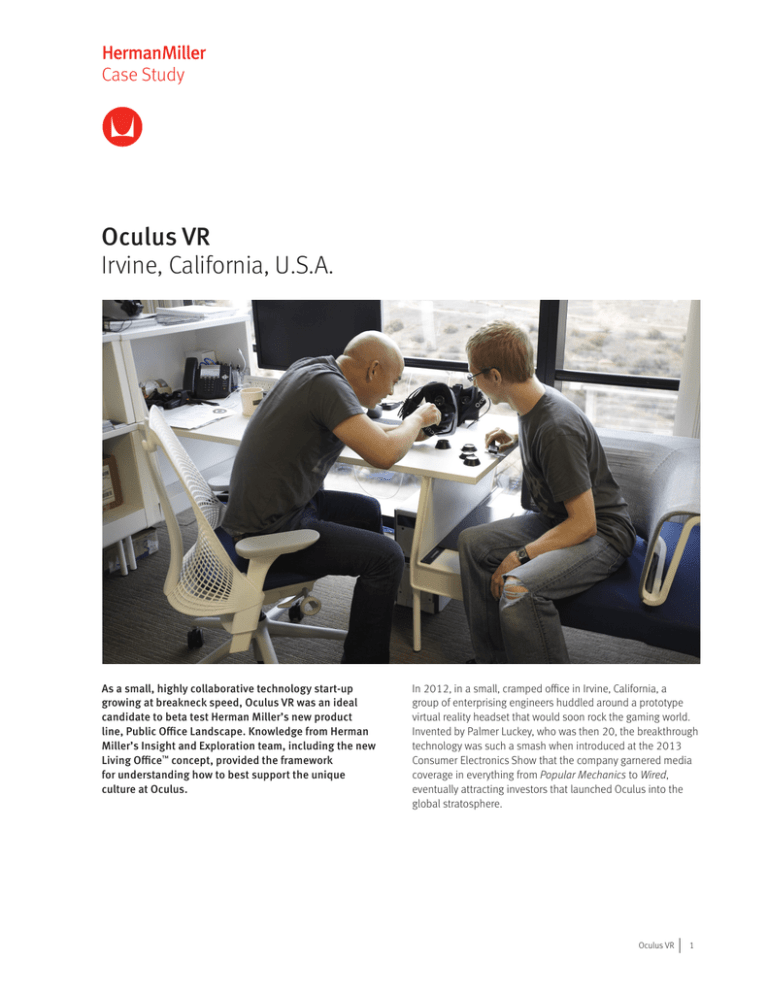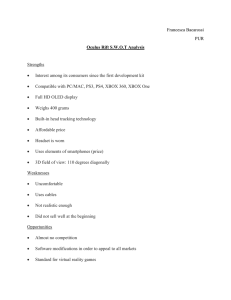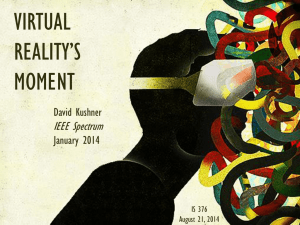Oculus VR Case Study
advertisement

Case Study Oculus VR Irvine, California, U.S.A. As a small, highly collaborative technology start-up growing at breakneck speed, Oculus VR was an ideal candidate to beta test Herman Miller’s new product line, Public Office Landscape. Knowledge from Herman Miller’s Insight and Exploration team, including the new Living Office™ concept, provided the framework for understanding how to best support the unique culture at Oculus. In 2012, in a small, cramped office in Irvine, California, a group of enterprising engineers huddled around a prototype virtual reality headset that would soon rock the gaming world. Invented by Palmer Luckey, who was then 20, the breakthrough technology was such a smash when introduced at the 2013 Consumer Electronics Show that the company garnered media coverage in everything from Popular Mechanics to Wired, eventually attracting investors that launched Oculus into the global stratosphere. Oculus VR 1 Case Study Strategically designed, open, transparent Settings facilitate face-to-face interactions among team members. Fast-paced, Collaborative Culture “Controlled Chaos" As a start-up growing at hyper speed, Oculus VR recognized it was at risk of losing its inherent cultural traits: a closely knit team of equal intellectuals, where constant chatter and close proximity kept ideas flowing and colliding constantly, sometimes literally sticking to walls, as new prototypes spilled continuously out of 3D printers. And all of this happened while a telepresence robot digitally connected one Oculus engineer working in Dallas to team members in California. Indeed, interaction and collaboration were critical in a culture that Chen describes as “controlled chaos.” Their existing space was not working for them. Furnished with rigid, linear benching, conversations were constrained, conducted standing up, or leaning over others. Product Lead Joe Chen was frustrated that it didn’t really foster the right kind of interaction; “accidental collaborations” that happen spontaneously were too infrequent. There weren’t enough spots for quiet conversations, either. He wanted to enhance the connectivity and impromptu discussions that are inherent to the company’s success. They also needed more room to accommodate their rapidly growing work force, but wanted the space to better support the way they worked, too. “We’re a very driven, performance-oriented company,” he explains. “We make things, and it’s a lot of ‘doing’ and not a lot of ‘managing.’ It’s messy, and we get our hands dirty; there’s a lot of back and forth communication, brainstorming, discovery, and experimentation, with people soldering at lab benches, prototypes in various states of disassembly, backpacks on the floor. But that controlled chaos is what ultimately gets us results and has gotten us to where we are today.” Living Office and Public Office Landscape Oculus VR was a perfect candidate to beta test a new product line that was in development at Herman Miller called Public Office Landscape. Designed by Yves Béhar and fuseproject, the line addresses needs uncovered by Herman Miller’s Insight and Exploration group, which had been studying workplaces around the world to observe different ways in which collaborations occur. Oculus VR 2 Case Study Researchers had found that what was once secondary to work—camaraderie, collaboration, interaction—had increasingly become primary. By differentiating the subtleties of how, when, where, and why people connect, the team had explored collaborative work behaviors and identified 10 Modes of Work, such as Converse, Chat, Huddle, Co-Create. They then defined a range of Settings—spaces optimized to support work and interaction—that enable these Modes of Work and help form the foundation to a concept called Living Office. Each Living Office is unique, based on the distinctive purpose, character, and activities of its inhabitants. It is affected by the culture of the company or country it’s in, as well as influences such as the needs and work styles of its workers. Knowledge is Critical Chen was intrigued by what Herman Miller researchers had found out about the changing work world. In fact, as Katie Lane, Product Management Director at Herman Miller recalls, “The relationship between Oculus VR and Herman Miller began with the knowledge we could provide about how people work. They wanted as much information as we could provide before making some of these critical space planning decisions moving forward.” Frequent consultations and conversations keep the ideas flowing at Oculus. Deanne Beckwith, Solutions Integrator at Herman Miller who met with Chen and other Oculus VR team members, says, “We were asked to create group and social spaces, not individual workstations. We needed to add to their higher performance value, make it a more collaborative environment, more livable, where someone can also have a quiet conversation, or just go take a nap. It also needed to be flexible enough to accommodate new people who were coming in, and also the global workers who weren’t always there.” Observing Modes of Work One of the first steps in achieving this goal was for Brian Green, Research Lead with Herman Miller’s Insight and Exploration group, to observe people at Oculus VR engaging in the various Modes of Work. What he saw were “people who interacted with each other many, many times a day, (exponentially) more so than any other company I’ve seen,” he notes. “These were typically short, two-to-three minute conversations about a task at hand or getting guidance on something.” Social Chairs, shown here in the lobby, are so welcoming and inviting they helped change the dynamic of how people interact at Oculus. Chen says Green’s many observations about their specific work habits, in addition to Herman Miller’s overall research, helped them identify “overall topography” that would support both the functions and culture of the company. Oculus VR 3 Case Study “It’s not just the furniture; it’s how you use that furniture to help people perform better and make them most effective,” he says. “It’s less about the furniture and more about the layout. We just want to do the best work possible; we keep what helps us and get rid of what doesn’t.” Public was a Natural Fit Because Oculus VR was growing so quickly—their staff had doubled in size in less than six months—the plan was to install Public Office Landscape in the original space to address people’s immediate needs. The company would then move into an interim space, where they’d stay temporarily until early 2014, when they could relocate to a new headquarters that would eventually house more than 100 employees. Public was a natural fit from the get-go. As a flexible system of components offering surfaces, seating, and storage, it enables a multitude of work Settings that help people work better together. Diverse designs keep the office in a state of flow, allowing people to engage, focus, and move freely between conversations. Making Connections At the time of the research, Oculus essentially had two teams, hardware and software. There were collaborative hubs on the floor plan, and the teams interacted often. Key players emerged, people who seemed to be the go-to individuals. Interactions could be typified as quick, knowledge sharing events that, in the pre-Public environment, were often conducted standing up. With the introduction of the Social Chair, these meetings changed. It introduced a social element to the conversation by offering up a place to sit. As a result, these conversations lasted a little longer, and others were often brought into the discussion. This broader interactive zone has inherent advantages: When people share ideas with others and contribute to ideas floating around them in conversations, connection occurs. People have a better grasp on what is happening around them and they have the opportunity to offer up their own suggestions or ideas. This benefits the organization in ways that are difficult to measure but are important and and have a positive impact. Public Peninsula Group Settings, shown here with Sayl® chairs, enable casual interactions that are critical to the Oculus VR work process. Oculus VR 4 Case Study One of the features the team likes best about its design is its line of sight: that is, what you see when you look up from where you are. As Green explains, “From a work process perspective, I can look up and see that Phil is at his desk; if he’s there, then he’s accessible if I have a quick question for him. So just that awareness, being able to see people across the space, is a huge deal for them.” The team also likes the fact that everything is in close proximity to each other, so people—and ideas—can seamlessly flow between the various spaces. Social Chair: Shining Star The Public Social Chair was a big hit, too. “The shining star,” as Green calls it, is the building block of the system and introduces a profoundly new level of ergonomic performance to casual seating, letting the sitter connect, relax, and easily move between postures, supporting the social nature of work. The chair was designed to be inviting, and it is, says Oculus designer Matt Ford. “It’s like a signal that says, ‘Come and sit;’ it’s an invitation to join me.” Supporting Collaboration Part of the research methodology for the Oculus study was analyzing collaborative patterns in the two spaces, before and after the installation of Public Office Landscape. A very different pattern emerged between the two that was primarily attributed to who was in the office on a particular day. The two images above, representing the software and hardware teams, depict where collaboration happened. The more intense collaborating group on the left is the software team, who was using a benching product prior to Public Office Landscape. After Public was moved in, researchers observed the hardware group being more collaborative. This shift of collaborative behavior was affected by who was present. Take a few people out and the collaborative landscape changed. This was very important when it came time to determine where groups sat and who should be closer to whom. It was also affected by the stage of development the company was in at the time. Immediate Results “The Social Chair really changed the dynamic of our office,” concurs Chen. “Literally, within 10 minutes, people were using them to stop and chat. Overall, people talk to each other more now. It’s nice that you can create a little huddle, where someone is at a desk, another is seated in the chair, another is perched, and another is standing, and they’re all very engaged in this impromptu interaction.” As Chen told Green, “It changed my own behavior; before, if I needed Matt for something, I’d pass by, tell him what I needed, then walk away. But now, I’ll come and sit and we can quickly work through an issue with a lot more clarity.” Lane points out that the Social Chair “supports multiple postures, such as reclining, perching, and leaning on the edge; there’s a universality to it. And from a comfort standpoint, it has many ergonomic attributes like our task chairs, a lot of intelligence and performance built into it that might not be immediately apparent.” Oculus VR 5 Case Study Flexible components allow people to move easily from conversation to conversation. Heads down work is also an integral part of the Living Office at Oculus. A Real Learning Experience Looking ahead, he’s already thinking about the kinds of challenges the next move will bring—and how they might be addressed. “Joe is a very thoughtful guy, and he’s really trying to use the knowledge and experience he’s gained to be strategic about their next move,” notes Green. Chen says because they had to move so quickly into the temporary space, “We didn’t have a lot of time to figure out what would be best for each individual group, software versus hardware versus logistics versus operations; they’re all such different ways of working. So we’re making adjustments as we go.” Planning New Headquarters Grateful for the learning experience living in the interim space has provided, he adds, “Right now we’re trying to figure out how to create a little more structure for folks who want that, and for people who need to tunnel in and concentrate.” In September, Chen and Oculus COO Laird Malamed, along with Matt Ford and Office Manager, Heidi Westrum, traveled to Chicago to work with the Herman Miller Living Office team in a one-day workshop to learn more about the Living Office concept. Chen has found the whole process to be a real eye opener, and he admits it’s been a bit painful at times. “I learned early on that many of my assumptions were wrong. I thought as an innovative start-up, our team would welcome change. But people generally don’t like change; it’s just human nature. Managing that component has been challenging, especially given the fact that we have another move coming up early next year. They’re reluctant to unpack the boxes they were reluctant to pack up in the first place.” For their new headquarters, they are considering a unique mix of Settings to support the needs of individuals and groups. For example, software and hardware engineers might have Hives, which give each team member a “home” and a place to get their individual work done in proximity to others. Clubhouses would provide working “neighborhoods” for those who need to work independently, but collaborate frequently. Executive offices will be interspersed rather than isolated, making the “commute” a short distance to peers and teams. “I also overlooked the variety of work modes and preferences to accommodate within our team, as well as equipment needs, and so on. So if we can’t individualize each space, at least we can offer some latitude to make adjustments as needed,” he says, referring to the flexibility of the Public components to move things around. Oculus VR 6 Case Study To accommodate its tremendous growth, Oculus VR moved into a larger, temporary space in the same building where its original office was located. Their new space will more than double in size from the temp space, and until it’s filled in with new hires, Chen worries about it being too isolating. “People think, great, I’m getting more space, but then they realize, wait, I don’t even talk to the three people I used to work with any more! So with the luxury of more space, we don’t want to lose that connectivity, which is so critical to the way we operate.” Industry Technology As Chen and many others are learning, a Living Office is a continually shifting landscape, one that requires information, planning, thought, and strategy. And there’s one more thing, says Chen, “We not only want to be more functional as we grow, we want to keep that energy, that controlled chaos, too.” Application Living Office Malamed summarized their philosophy by stating, “We don’t want to make a cliché environment with elements that are meaningless to us; we want to create a space that reflects our open culture and transparent outlook, reminding us every day of who we really are.” Photo credit: David Ellison Topics Collaboration Engagement Performance Herman Miller Products Public Office Landscape™ Resolve® System Sayl® Chairs Setu® Chair Everywhere™ Tables Year Completed 2013 (original suite and temporary space) Project Scope Original suite: 7,000 sq. ft., 11 people Temporary space: 12,000 sq. ft., capacity up to 60 people © 2013 Herman Miller, Inc. Zeeland, Michigan ®Herman Miller, Resolve, Sayl, and Setu are among the registered trademarks of Herman Miller, Inc. ™Everywhere, Living Office, and Public Office Landscape are among the trademarks of Herman Miller, Inc. Oculus VR 7

